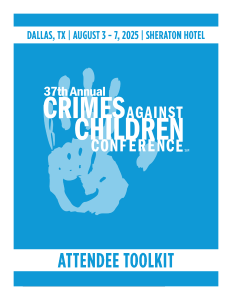Workshop
Sheraton Conference Center - 3rd Floor
A Day in the Life: How Exposure to Community Violence Impacts Children
Monday, August 4, 2025
12:00 PM – 1:15 PM CT
Location: Houston A
Earn 1.25 Credit Hours
Target Audience: Law Enforcement, Victim Advocate, Therapist, CPS, CAC

Andrew Campbell (he/him/his)
CEO
Campbell Research & Consulting
Primary Presenter(s)
This presentation will describe the many risks of harm (short-term and long-term) for children exposed to violence in their community. As rates of violent crimes continue to increase across the United States, all victim-serving disciplines must gain greater insight into the damaging effects of exposure to these incidents on the children who reside in their community. With a focus on the emotionally-damaging nature of this exposure, outcome differences by: race, gender, age, proximity, and frequency of community violence exposure will be discussed.
In addition, this training will discuss the overlap between exposure to violence as a child, and risks for subsequent victimization or perpetration of violence in the home and/or community as an adolescent or adult. Finally, critical components of effective and efficient community-inclusive, multi-disciplinary intervention efforts will be described.
In addition, this training will discuss the overlap between exposure to violence as a child, and risks for subsequent victimization or perpetration of violence in the home and/or community as an adolescent or adult. Finally, critical components of effective and efficient community-inclusive, multi-disciplinary intervention efforts will be described.
Learning Objectives:
- List similarities and differences in how children process community violence and family violence.
- Describe internalizing and externalizing child behaviors associated with witnessing community violence.
- Demonstrate knowledge of key concepts for improving physical and mental health outcomes for children exposed to community violence.

